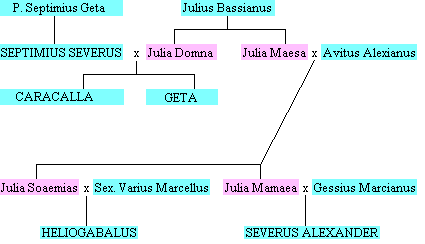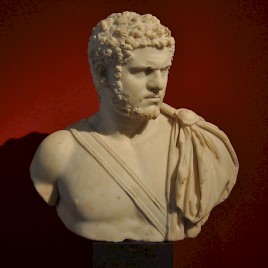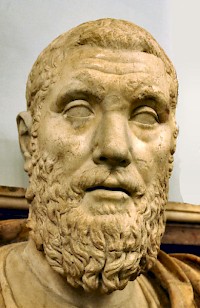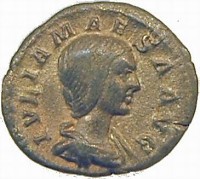Heliogabalus (2)
Heliogabalus: emperor of Rome, ruled from 218 to 222, famous for his religious reforms and the introduction of the cult of the Syrian sun god Elagabal.
Life (Asia)
Family

The name of Heliogabalus' real father was Sextus Varius Marcellus. This man served under the emperors Septimius Severus (193-211) and Caracalla (211-217). According to Cassius Dio and Herodian, the boy's mother was Julia Soaemias, who was in turn a daughter of Julia Maesa, the sister of Julia Domna, wife of Septimius Severus. Julia Maesa and Julia Domna were the daughters of the high priest in Emesa, Julius Bassianus.


During Septimius' reign, Julia Maesa came to Rome and brought her daughter Soaemias with her. The young woman met her cousin, prince Caracalla, and Heliogabalus is sometimes portrayed as the bastard son of Caracalla and Julia Soaemias, conceived during this period.
Julia Soaemias had a sister named Julia Mamaea, who was married to Gessius Marcianus and had a son as well, Alexianus. He was to succeed Heliogabalus under the name of Severus Alexander.
Caracalla, Macrinus and Varius Avitus Bassianus
In 217, the emperor Caracalla was murdered during a journey to Harran, where he wanted to sacrifice to the moon god Sin. Between Edessa and the temple city, Caracalla dismounted to relieve his bladder, but when he was again mounting his horse, a dagger was forced into his side by an associate of the praetorian prefect: Marcus Opellius Macrinus, who became emperor. The empress-mother, Julia Domna, refused to eat and drink and died shortly after her son, and her sister Julia Maesa returned to Emesa. Macrinus allowed her to keep her fortune - a fatal error, as we will see below.

Caracalla had been in Mesopotamia to fight a war against the Parthian Empire. The armies of the new emperor and king Artabanus IV met near Nisibis, and the result is presented in our sources as a Roman defeat - but the sources are generally hostile towards Macrinus, and perhaps the fight was less decisive than is assumed. (Had the new emperor really been defeated, he would have been killed by his soldiers straight-away.) An armistice was concluded, and the Romans agreed to pay an indemnity, which offered them a breathing space to consolidate some gains they had already made in Armenia. Later, this policy was regretted, but in the summer of 217, it was not a bad idea to buy peace and concentrate upon other things.
Still, the soldiers and many senators were unhappy with the new ruler. The war against the Parthians had not been won and Macrinus had not left for Rome, where he should have paid his respect to the Senate. To make matters worse, military supplies were short and the soldiers were not sent home. Revolt was in the air.

At this time Heliogabalus - or, as he was still called, Varius Avitus Bassianus - was fourteen years old and his nephew Alexianus was nine. Both were dedicated to the service of the Emesene god Sol Invictus Elagabal, and Heliogabalus was next in line to become the god's high priest. According to Herodian, he was a good-looking boy, often compared to the god Dionysus, and drew large crowds of legionaries, stationed in Raphanaea near Emesa, when he appeared in public to perform his cult activities. Julia Maesa played upon the emotions of the soldiers by telling them that Heliogabalus was the son of Caracalla, who had been loved by the army - a trick that was proposed by her lover, Gannys. Not only did Julia Maesa give the soldiers the information they liked to hear, she also promised them mountains of gold if they would restore her family to the throne. She bribed the garrison at Raphanaea, and on 16 May 218, the Third Legion Gallica switched its allegiance from "the usurper Macrinus" to the boy Bassianus.
The news spread quickly and reached Macrinus, who was stationed at Antioch with his army. However, he did not take the rumors seriously and sent a small delegation to take care of the rebels. Once the delegation arrived, the rebels succeeded in persuading the new arrivals to revolt as well. Praetorian prefect Ulpius Julianus, who led the delegation, was decapitated and his head was sent to Macrinus.
Hearing of the defeat, Macrinus mobilized the soldiers of the Second Legion Parthica. He did not yet tell his troops about the revolt but instead promoted his son Diadumenianus to the rank of co-ruler (augustus) and promised the soldiers 20.000 sesterces, donating 4000 on the spot. After these precautions, the army marched on Emesa.
On 8 June 218, the two armies met and again Macrinus' army deserted him. Fearing for his life, the emperor fled, even though his bodyguards and the praetorians kept fighting for his cause. Once they detected his absence, however, they were persuaded by the rebels to desert Macrinus as well, and they were pardoned by Heliogabalus.
The defeated monarch fled to Rome, hoping to gain support from the Senate and the people, but he was seized in Chalcedon in Bithynia by Aurelius Celsus and taken to Cappadocia, where he was decapitated by Marcianus Taurus. His son Diadumenianus was murdered as well, "having gained nothing from the imperial power but his death at the hands of the soldiers", as the author of the Historia Augusta briefly summarizes.note Because Macrinus had been consul at the time of his death, Heliogabalus was able to enter this office immediately.
The boy was now proclaimed emperor by the soldiers. He took on the name that his "father" had used: Marcus Aurelius Antoninus, who had in turn borrowed this name from the beloved philosopher-emperor who had ruled from 161 to 180. The new emperor sent letters to the Senate in which he spoke of his descent from Caracalla. The people awaited his approach with much enthusiasm and the Senators agreed unanimously that Heliogabalus was to become the new emperor.
The road to Rome
Heliogabalus, who hade entered his second consulship on 1 January 219 (with Quintus Tineius Sacerdos), set out for Rome, bringing along his Emesene god Elagabal, in the form of the baetyl, and all his belongings. When he arrived in Antioch he offered each of his soldiers 2000 sesterces to prevent them from sacking the city. He forwarded news to the Senate in which he degraded Macrinus, and the senators wrote back that they hoped that he would be a new Caracalla, carefully omiting the things they had hated about the latter. The young man immediately received the title of pater patriae, "father of the fatherland", and was coopted in all priestly colleges of the city.
Heliogabalus spent the winter in Nicomedia. Yet he had given the Romans a foretaste by sending an image of himself, clad in his cultic robes and sacrificing to the baetyl. According to Herodian, the painting was to be hung in the Senate's house above the statue of Victoria:
Therefore he had a huge full-length painting made of himself performing his priestly duties. He was painted making a sacrifice to his god, whom he also had depicted in the painting. He sent it to Rome with the order that it be hung up in the middle of a wall in the assembly hall in the Senate, very high, above the head of Victoria, in front of which the senators would offer up incense and wine when the Senate was in session.note
The senators were probably not amused that they could not bring their customary sacrifice without sacrificing to the boy-emperor as well. Eventually, Heliogabalus arrived in the capital in the late summer of 219.
The author of the Historia Augusta says that he was already misbehaving in Nicomedia and that the soldiers were already disgusted by this conduct and regretted their decision to make Heliogabalus emperor .note This probably refers to the presumed revolt of III Gallica, to which the emperor owned his throne. The legion was disbanded. Probably, the advisers of Heliogabalus had been looking for an occasion to do this, because a ruler was not supposed to owe the throne to someone else. We don't know if the soldiers were really rebellious, but disbanding the unit made sense.
There were other rebellions in the east. Gellius Maximus, the commander of IV Scythica, was executed on a charge of treason, and it is certain that a man named Uranius was ruler of an independent Emesa. Perhaps this happened with permission of a grateful Heliogabalus. Another victim of the regime was Gannys, who was murdered in Nicomedia, perhaps by the boy-emperor himself. Again, it made sense: he had too clearly served as "king maker".
As soon as he arrived in Rome, Heliogabalus married. His bride Cornelia Paula belonge to an ancient aristocratic family. He married so quickly in order to become a father sooner, and continue the dynasty. This marriage, however, did not last long, for Heliogabalus had fallen in love with a Vestal Virgin - or so it is said - and in the first weeks of 220 divorced his first wife in order to marry this priestess named Julia Aquilia Severa.
At that moment, he was consul for the third time, with Publius Valerius Comazon Eutychianus, former commander of III Gallica and now praetorian prefect. It was not common to be consul in three consecutive years; the last emperor to do so, was Domitian, and ever since, it was considered despotical. Heliogabalus took a risk.
Cassius Dio explains that Heliogabalus send away his first wife because she had a blemish on her body, whatever this may mean, and also because he "wished to produce godlike children"..note As high priest of Sol Invictus Elagabal, he believed himself to be the incarnation of his god. As a corollary, Aquilia, who was the head priestess of Vesta, was in his eyes the incarnation of a goddess.
Julia Aquilia Severa, however, was bound by sacred law to remain a virgin. With his second marriage Heliogabalus violated the most sacred and ancient of all cults in Rome. He however sent a letter to the Senate excusing himself, for he had fallen in love. Perhaps this is true, because Dio says that Heliogabalus married many women but eventually ended up marrying Aquilia again. On the other hand, there is a plausible religious motive, as we will see below.
From the evidence of Alexandrine coins, it is known that Heliogabalus' third marriage took place in July 221. Annia Aurelia Faustina traced her family ties back to Commodus, the son of Marcus Aurelius. However, by the end of 221, he had already remarried Julia Aquilia Severa.